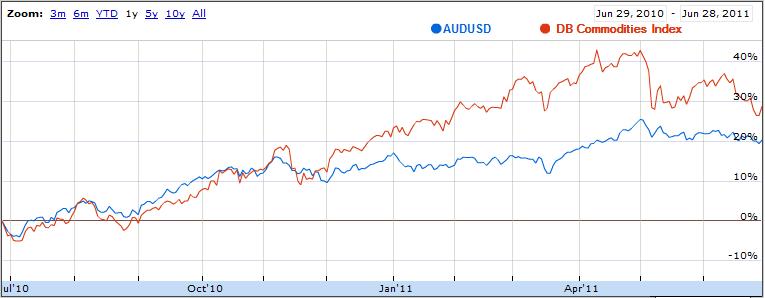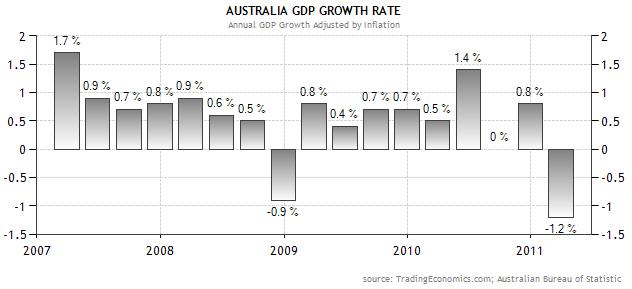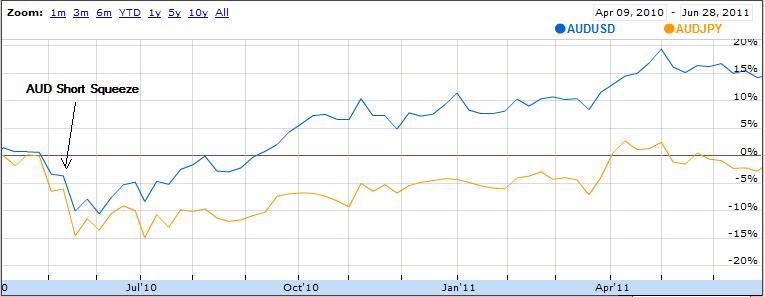June 29th 2011
Tide is Turning for the Aussie
“Australia is about to enter a boom that should last decades…The Australian dollar is unlikely to go back to where it was, and manufacturing will shrink in importance to the economy, perhaps even faster than it has been.” This, according to Martin Parkinson, Treasury Minister of Australia. While 30 years from now, Mr. Parkinson’s prognosis might probe to be accurate, I’m not so sure it applies to the period 3 months from now. Here’s why:
First of all, the putative economic boom that is taking place in Australia is being driven entirely by high commodity prices and surging production and exports. Since peaking at the end of April, commodity prices have fallen mightily. You can see from the chart above that there continues to exist a tight correlation between the AUD/USD and commodities prices. As commodities prices have fallen over the last two months, so has the Australian Dollar.

In addition, while demand will probably remain strong over the long-term, it may very well slacken over the short-term, due to declining economic growth across the industrialized world. Consider also that Australia’s largest market for commodity exports – China – may have difficulty sustaining a GDP growth rate of 10%, and at the very least, new fixed-asset investment (which necessitates demand for raw materials) will temporarily peak in the immediate future.
Finally, the mining sector directly accounts for only 8% of Australia’s economy, which means that only to a limited extent to high commodities prices contribute to the bottom line of Australian GDP. This notion is reinforced by the 1.2% economic contraction in the second quarter – the biggest decline in 20 years – and the fact that GDP is basically flat over the last three quarters. Many non-mining economic indicators are sagging, and the number of corporate bankruptcies is 10% higher than in 2010. In the end, then, the ebb and flow of Australia’s fortune depends less on commodities, and more on other sectors.

Mr. Parkinson’s optimistic forecasts might also be undermined in the short-term by a looser-than-expected monetary policy. The Reserve Bank of Australia last hiked its benchmark interest rate in November 2010, and may not hike again for a few more months due to moderating economic growth and proportionally moderate inflation. Given that an attractive interest rate differential may be driving some of the speculative activity that has girded the Aussie’s rise, a decline in this differential could likewise propel it downward.
That’s because anecdotal reports suggest that the Australian Dollar remains a popular long currency for carry traders, funded by shorting the US Dollar, and to a lesser extent, Japanese Yen. Given that many of these carry trades are heavily leveraged, it wouldn’t take much to trigger a short squeeze and a rapid decline in the AUD/USD. For evidence of this phenomenon, one has to look no further back than May 2010, when the Aussie fell 10-15% in only three weeks.

Ultimately, as one commentator recently pointed out, the Aussie’s 70% rise since 2008 might better be seen as US Dollar weakness (which also catalyzed the rise in commodity prices). The apparent stabilizing of the dollar, then, might let some air out of the currency down under.




June 29th, 2011 at 10:34 pm
Looking back, your past articles and predictions about the aussies have been incorrect. LOL
July 6th, 2011 at 5:56 am
Australian Dollar truly remains a popular long currency for carry traders, funded by shorting the US Dollar, and to a lesser extent, the Japanese Yen.
July 15th, 2011 at 6:49 am
Great post. Although, unless the USD & AUD are in parallel, I am not willing to pin much hope on this Oz revival right now.
August 10th, 2011 at 9:20 pm
Hi,
Just found your blog, looks great and will bookmark it. I do have a couple of questions I’d like to throw at you…
1) I noticed when I compared the chart of the AUD/USD over the past two or so years to the chart of the RBA o/n rate, and noticed a striking inverse correlation, i.e. when the RBA was on hold, the AUD soared, and when they were actively hiking rates, the AUD went sideways or down, but never up. Can you elaborate no why? I have asked this question a few times but no one seems to have an answer.
2) China is loving the weak USD compared to their CNY, so they can export their inflation. But what about the CNY compared to the AUD. Over the past two years, the CNY has depreciated quite considerably against the AUD. Would this concern China any, and if it was to become a concern, what would the Chinese seek to do about it? Is the strong AUD/CNY telling us anything fundamentally?
Cheers
Dean
October 3rd, 2011 at 9:23 am
I visit your site everyday to read brand new ideas.
October 24th, 2011 at 3:55 pm
Yeah, right, inflation.
October 31st, 2011 at 3:01 pm
Yes, who would have thought Aus/Usd would be where it is today? over parity.. crazy times..
March 11th, 2012 at 4:40 am
A LOT of the aud price is going to be determine by interest rates. The biggest factor for the Aussies run is traders and not just currency traders looking to put there money somewhere that the returns are worth the risk. Most of the developed world is pushing interest rates closer and closer to zero. Meanwhile Australia is either raising or staying put. There might be a nice correlation between commodity prices but that corrrelation will break if commodities fall but Australia keeps rates high. Which leads me to my speculations. If the united states economy continues to improve and commodities/inflation continue to rise the fed will be forced to not only pull the plug on QE but sooner or later start the rate hike cycle. This will eventually lead to weaker commodities and stronger dollar as there is also inverse relation. So the Aussie may slow or even weaken against the dollar it doesn’t mean the aud will just fall. Trades will just start using other currencies such as the yen to fund carry trades. I don’t know if ever in my lifetime I will see the Japanese fighting inflation thus raising rates. One has to wonder if traders see the writing on the wall that the dollar will become increasingly difficult to short/fund carry trade thus the sudden shift in a weakening yen in the face of a long-term and stubborn yen appreciation. The stimulus obivously is a big factor but I can’t help but wonder traders will soon be more interested in using the yen for their speculative funding currency. Personally I think the Aussie yen is the homerun trade of the year. Jmo
March 12th, 2012 at 11:14 am
Kathy I agree with your directional call on the A$.
The rationale I shared fundamentally and technically were different from the ones you gave, but with the same forecast outcomes. The different cases can be found at:
fundamentals:http://simonkerrhfblog.blogspot.com/2012/03/bridgewater-associates-and-aussie.html
technicals: http://simonkerrhfblog.blogspot.com/2012/03/chart-of-day-is-technical-position-of.html
Keep up the good work.
July 19th, 2013 at 2:29 am
i agree with this post